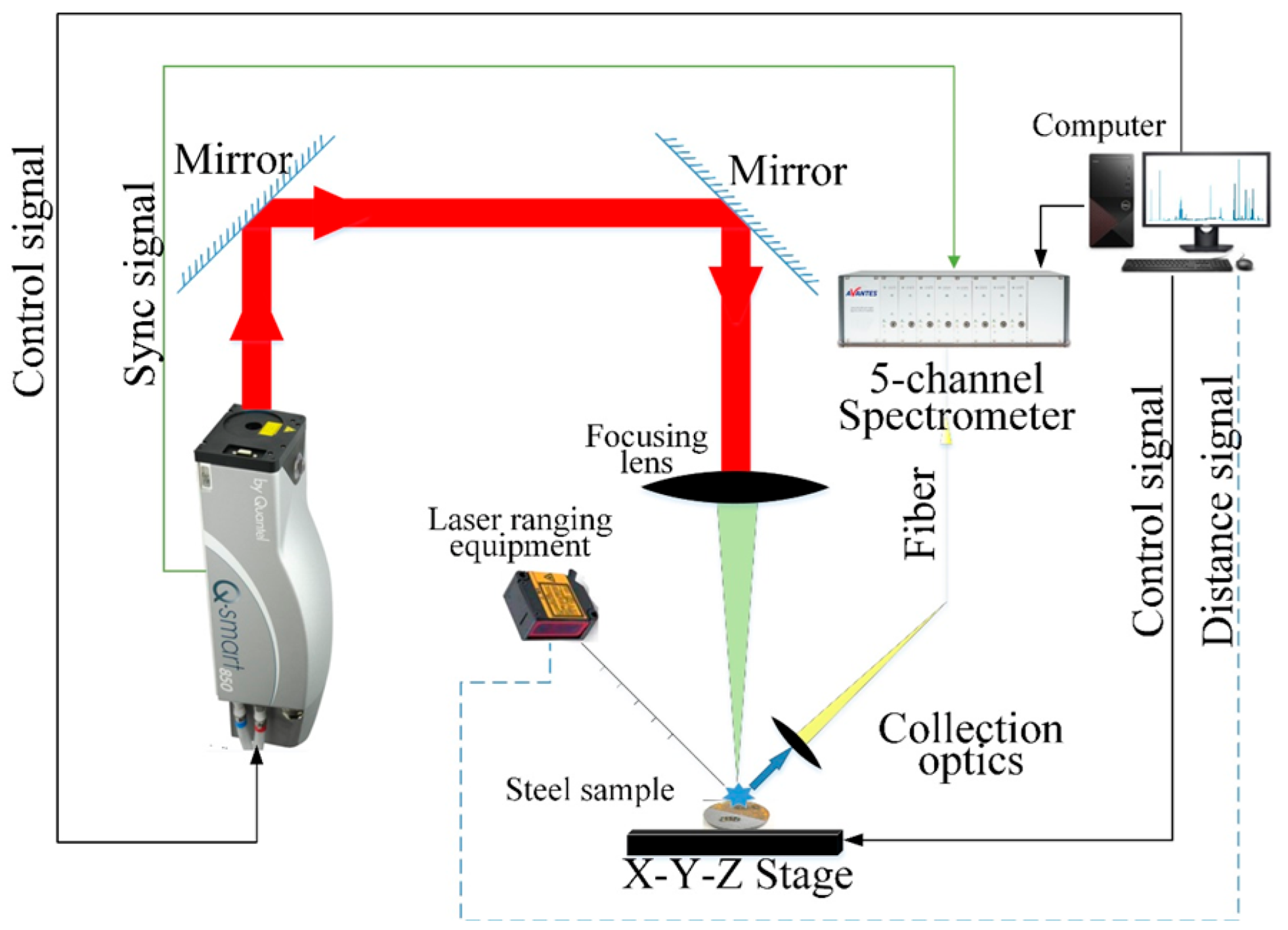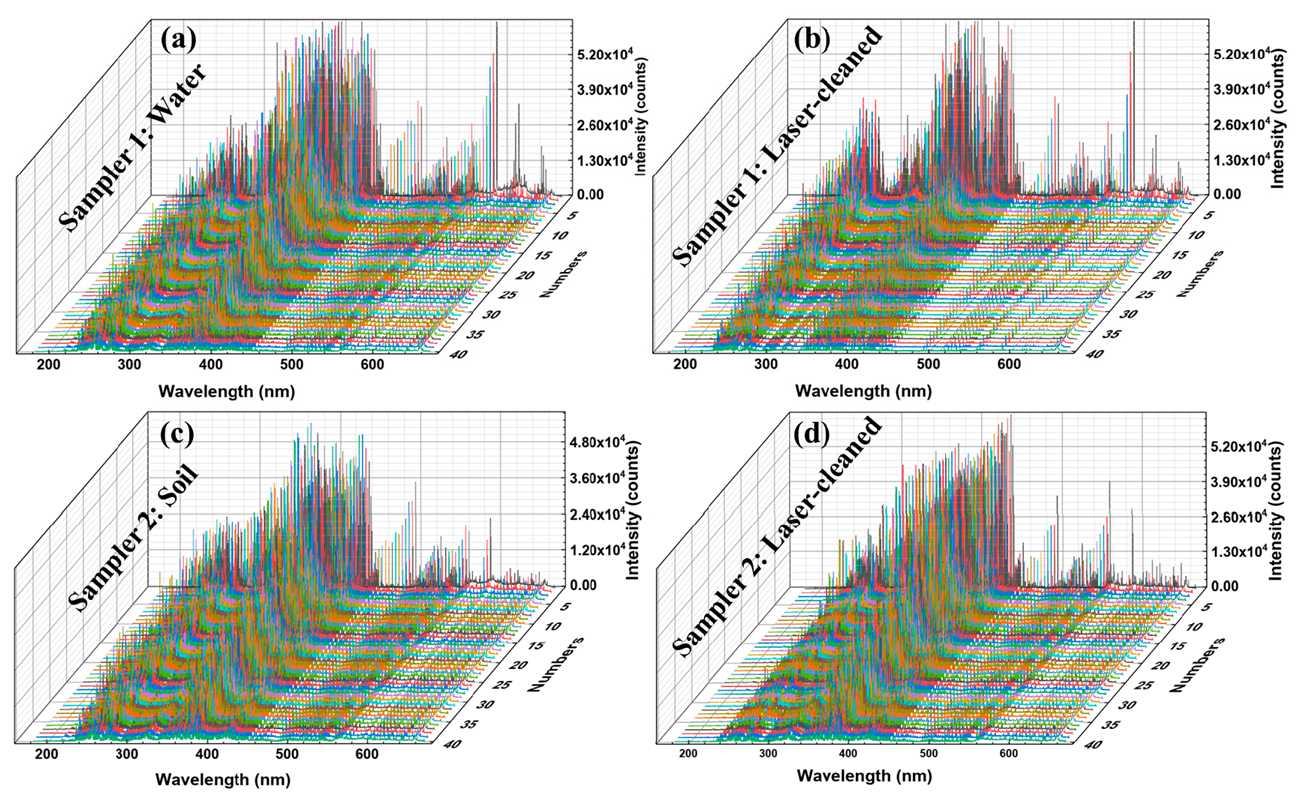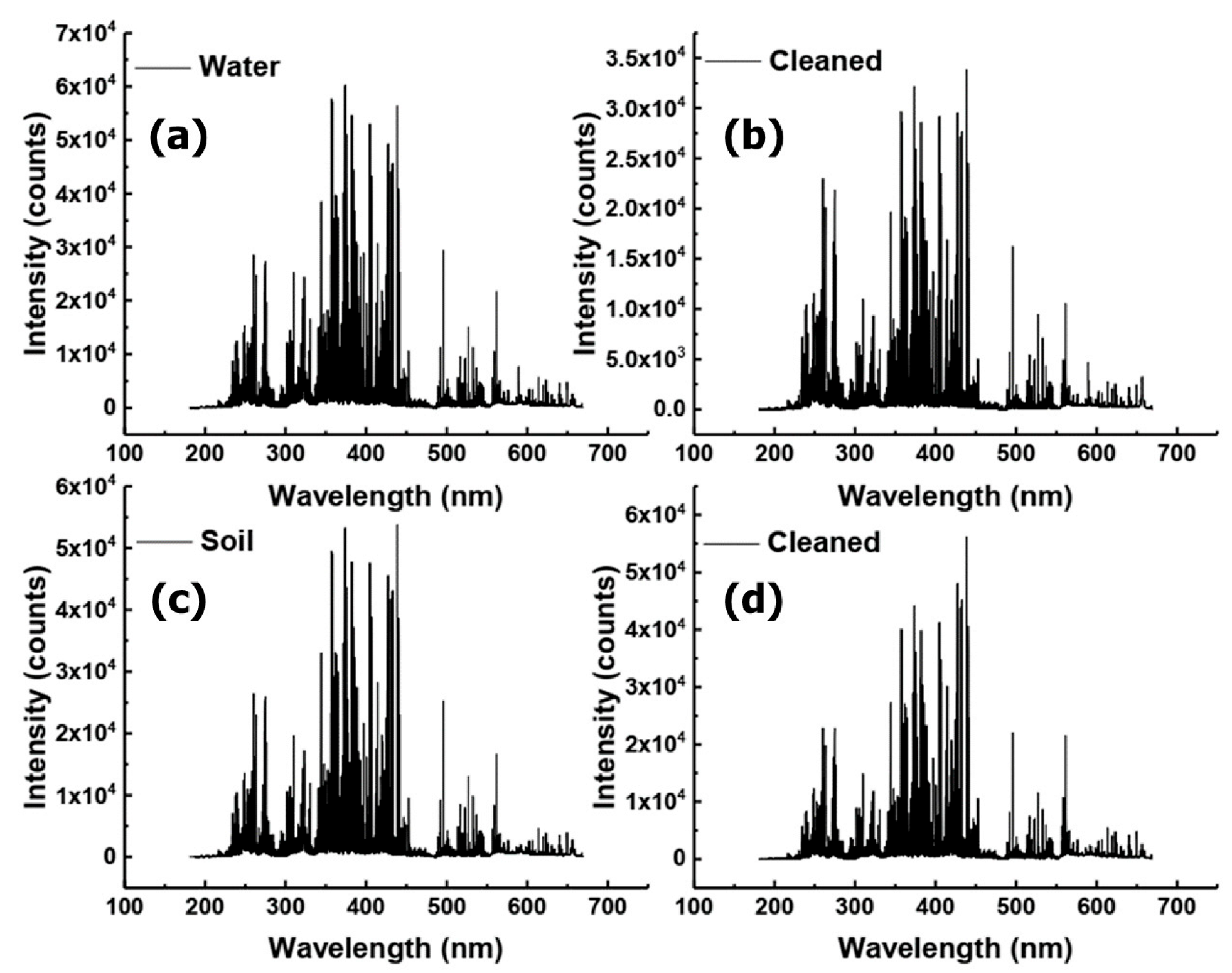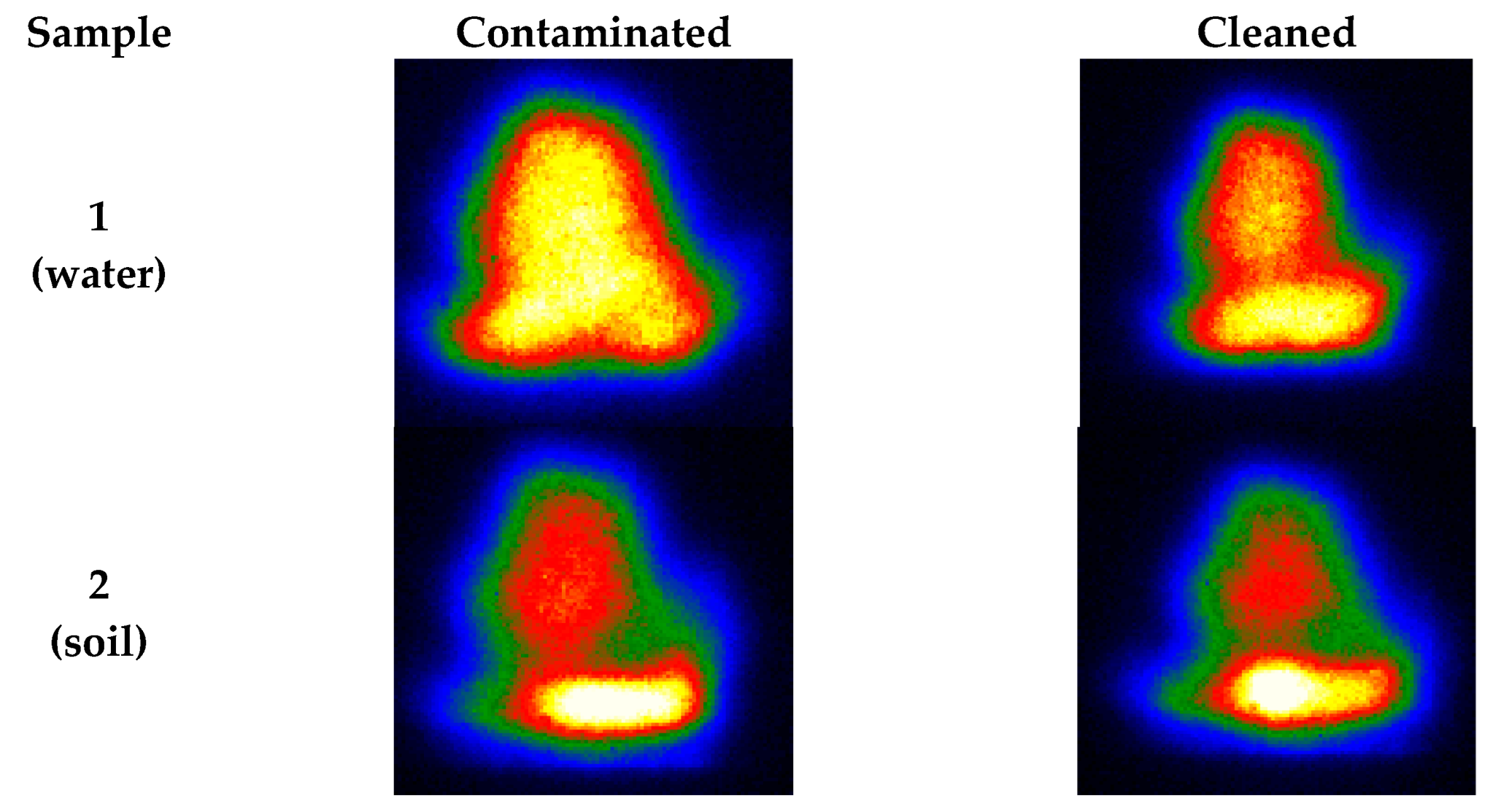Evaluation of the Laser Cleaning Efficacy of Q235 Steel Using Laser-Induced Breakdown Spectroscopy
Abstract
:1. Introduction
2. Materials and Methods
2.1. Sample Preparation
2.2. Experimental Setup
3. Results and Discussion
3.1. LIBS Spectra
3.2. Analysis and Methods
4. Conclusions
Author Contributions
Funding
Data Availability Statement
Conflicts of Interest
References
- World Steel in Figures. Available online: https://worldsteel.org/wp-content/uploads/World-Steel-in-Figures-2022.pdf (accessed on 7 June 2022).
- Wada, T.; Hagel, W.C. Effect of trace elements, molybdenum, and intercritical heat treatment on temper embrittlement of 2-1/4Cr-1 Mo steel. Metall. Trans. A 1976, 7, 1419–1426. [Google Scholar] [CrossRef]
- Swindeman, R.; Sikka, V.; Klueh, R. Residual and trace element effects on the high-temperature creep strength of austenitic stainless steels. Metall. Trans. A 1983, 14, 581–593. [Google Scholar] [CrossRef]
- Melford, D. The influence of residual and trace elements on hot shortness and high temperature embrittlement. Philos. Trans. R Soc. Lond. A 1980, 295, 89–103. [Google Scholar] [CrossRef]
- Zhang, Y.; Sun, C.; Gao, L.; Yue, Z.; Shabbir, S.; Xu, W.; Wu, M.; Yu, J. Determination of minor metal elements in steel using laser-induced breakdown spectroscopy combined with machine learning algorithms. Spectrochim. Acta Part B At. Spectrosc. 2020, 166, 105802. [Google Scholar] [CrossRef]
- Brook, R.; Da Silva, P.S.P. The influence of manganese on the fracture toughness of nickel steels. Int. J. Fract. 1976, 12, 27–32. [Google Scholar] [CrossRef]
- Maslyuk, V.A.; Lvova, G.G.; Kurovskii, V.Y.; Mamonova, A.A. Effect of chromium and manganese nitrides on the structure and properties of Kh18N15 powder stainless steel. Powder Metall. Met. Ceram. 2011, 50, 289. [Google Scholar] [CrossRef]
- Tiwari, M.K.; Singh, A.K.; Sawhney, K.J.S. Analysis of stainless steel samples by energy dispersive X-ray fluorescence (EDXRF) spectrometry. Bull. Mater. Sci. 2001, 24, 633–638. [Google Scholar] [CrossRef] [Green Version]
- Nagoshi, M.; Aoyama, T.; Tanaka, Y.; Ishida, T.; Kinoshiro, S.; Kobayashi, K. Quantitative Analysis of Nb in Steel Utilizing XRF-yield XAFS Edge Jump. ISIJ Int. 2013, 53, 2197–2200. [Google Scholar] [CrossRef] [Green Version]
- Bosco, G.L. Development and application of portable, hand-held X-ray fluorescence spectrometers. TrAC Trends Anal. Chem. 2013, 45, 121–134. [Google Scholar] [CrossRef]
- Volkov, A.I.; Alov, N.V. Method for improving the accuracy of continuous X-ray fluorescence analysis of iron ore mixtures. J. Anal. Chem. 2010, 65, 732–738. [Google Scholar] [CrossRef]
- Wang, Z.; Deguchi, Y.; Shiou, F.; Yan, J.; Liu, J. Application of laser-induced breakdown spectroscopy to real-time elemental monitoring of iron and steel making processes. ISIJ Int. 2016, 56, 423–435. [Google Scholar] [CrossRef] [Green Version]
- Hemmerlin, M.; Meilland, R.; Falk, H.; Wintjens, P.; Paulard, L. Application of vacuum ultraviolet laser-induced breakdown spectrometry for steel analysis—Comparison with spark-optical emission spectrometry figures of merit. Spectrochim. Acta Part B At. Spectrosc. 2001, 56, 661–669. [Google Scholar] [CrossRef]
- Kataoka, H.; Okamoto, Y.; Matsushita, T.; Tsukahara, S.; Fujiwara, T.; Wagatsuma, K. Magnetic drop-in tungsten boat furnace vaporisation inductively coupled plasma atomic emission spectrometry (MDI-TBF-ICP-AES) for the direct solid sampling of iron and steel. J. Anal. Atomic Spectrom. 2008, 23, 1108–1111. [Google Scholar] [CrossRef]
- Wiltsche, H.; Brenner, I.B.; Prattes, K.; Knapp, G. Characterization of a multimode sample introduction system (MSIS) for multielement analysis of trace elements in high alloy steels and nickel alloys using axially viewed hydride generation ICP-AES. J. Anal. Atomic Spectrom. 2008, 23, 1253–1262. [Google Scholar] [CrossRef]
- Yasuhara, H.; Okano, T.; Matsumura, Y. Determination of trace elements in steel by laser ablation inductively coupled plasma mass spectrometry. Analyst 1992, 117, 395–399. [Google Scholar] [CrossRef]
- Okano, G.; Igarashi, S.; Ohno, O.; Yamamoto, Y.; Saito, S.; Oka, Y. Determination of trace amounts of bismuth in steel by ICP-MS through a cascade-preconcentration and separation method. ISIJ Int. 2015, 55, 332–334. [Google Scholar] [CrossRef] [Green Version]
- Finkeldei, S.; Staats, G. ICP-MS—A powerful analytical technique for the analysis of traces of Sb, Bi, Pb, Sn and P in steel. Fresenius’ J. Anal. Chem. 1997, 359, 357–360. [Google Scholar] [CrossRef]
- Weyrauch, M.; Oeser, M.; Brüske, A.; Weyer, S. In Situ high-precision Ni isotope analysis of metals by femtosecond-LA-MC-ICP-MS. J. Anal. Atomic Spectrom. 2017, 32, 1312–1319. [Google Scholar] [CrossRef]
- Paulsen, P.J.; Alvarez, R.; Mueller, C.W. Trace Element Determinations in a Low-Alloy Steel Standard Reference Material by Isotope Dilution, Spark Source Mass Spectrometry. Appl. Spectmsc. 1976, 30, 42–46. [Google Scholar] [CrossRef]
- Seki, T.; Takigawa, H.; Hirano, Y.; Ishibashi, Y.; Oguma, K. On-line preconcentration and determination of lead in iron and steel by flow injection-flame atomic absorption spectrometry. Anal. Sci. 2000, 16, 513–516. [Google Scholar] [CrossRef]
- Ning, X.-A.; Zhou, Y.; Liu, J.-Y.; Wang, J.-H.; Li, L.; Ma, X.-G. Determination of metals in waste bag filter of steel works by microwave digestion-flame atomic absorption spectrometry. Spectrosc. Spectral Anal. 2011, 31, 2565–2568. [Google Scholar] [CrossRef]
- Noll, R.; Fricke-Begemann, C.; Connemann, S.; Meinhardt, C.; Sturm, V. LIBS analyses for industrial applications—An overview of developments from 2014 to 2018. J. Anal. Atomic Spectrom. 2018, 33, 945–956. [Google Scholar] [CrossRef] [Green Version]
- Hahn, D.W.; Omenetto, N. Laser-Induced Breakdown Spectroscopy (LIBS), Part II: Review of Instrumental and Methodological Approaches to Material Analysis and Applications to Different Fields. Appl. Spectmsc. 2012, 66, 347–419. [Google Scholar] [CrossRef] [PubMed]
- Yang, J.; Li, X.; Lu, H.; Xu, J.; Li, H. An LIBS quantitative analysis method for alloy steel at high temperature based on transfer learning. J. Anal. Atomic Spectrom. 2018, 33, 1184–1195. [Google Scholar] [CrossRef]
- Kondo, H. Comparison between the characteristics of the plasmas generated by laser on solid and molten steels. Spectrochim. Acta Part B At. Spectrosc. 2012, 73, 20–25. [Google Scholar] [CrossRef]
- Rai, A.K.; Yueh, F.Y.; Singh, J.P.; Zhang, H. High temperature fiber optic laser-induced breakdown spectroscopy sensor for analysis of molten alloy constituents. Rev. Sci. Instrum. 2002, 73, 3589–3599. [Google Scholar] [CrossRef]
- Pan, C.-Y.; Du, X.-W.; An, N.; Han, Z.-Y.; Wang, S.-B.; Wei, W.; Wang, Q.-P. Laser-induced breakdown spectroscopy system for elements analysis in high-temperature and vacuum environment. Spectrosc. Spectral Anal. 2013, 33, 3388–3391. [Google Scholar] [CrossRef]
- Hermann, J.; Axente, E.; Craciun, V.; Taleb, A.; Pelascini, F. Evaluation of pressure in a plasma produced by laser ablation of steel. Spectrochim. Acta Part B At. Spectrosc. 2018, 143, 63–70. [Google Scholar] [CrossRef] [Green Version]
- Hermann, J.; Grojo, D.; Axente, E.; Craciun, V. Local thermodynamic equilibrium in a laser-induced plasma evidenced by blackbody radiation. Spectrochim. Acta Part B At. Spectrosc. 2018, 144, 82–86. [Google Scholar] [CrossRef] [Green Version]
- Hermann, J.; Grojo, D.; Axente, E.; Gerhard, C.; Burger, M.; Craciun, V. Ideal radiation source for plasma spectroscopy generated by laser ablation. Phys. Rev. E 2017, 96, 053210. [Google Scholar] [CrossRef]
- Hermann, J.; Lorusso, A.; Perrone, A.; Strafella, F.; Dutouquet, C.; Torralba, B. Simulation of emission spectra from nonuniform reactive laser-induced plasmas. Phys. Rev. E 2015, 92, 053103. [Google Scholar] [CrossRef] [PubMed]
- Carlhoff, C.; Lorenzen, C.J.; Nick, K.P.; Siebeneck, H.J. Liquid steel analysis by laser-induced emission spectroscopy. In Proceedings of the SPIE In-Process Optical Measurements, Hamburg, Germany, 19–23 September 1989; pp. 194–196. [Google Scholar]
- Aragón, C.; Aguilera, J.A.; Campos, J. Determination of Carbon Content in Molten Steel Using Laser-Induced Breakdown Spectroscopy. Appl. Spectmsc. 1993, 47, 606–608. [Google Scholar] [CrossRef]
- Sun, L.X.; Xin, Y.; Cong, Z.B.; Li, Y.; Qi, L.F. Online compositional analysis of molten steel by laser-induced breakdown spectroscopy. Adv. Mat. Res. 2013, 694–697, 1260–1266. [Google Scholar] [CrossRef]
- Noll, R.; Bette, H.; Brysch, A.; Kraushaar, M.; Mönch, I.; Peter, L.; Sturm, V. Laser-induced breakdown spectrometry—Applications for production control and quality assurance in the steel industry. Spectrochim. Acta Part B At. Spectrosc. 2001, 56, 637–649. [Google Scholar] [CrossRef]
- Peter, L.; Sturm, V.; Noll, R. Liquid steel analysis with laser-induced breakdown spectrometry in the vacuum ultraviolet. Appl. Opt. 2003, 42, 6199–6204. [Google Scholar] [CrossRef] [PubMed] [Green Version]
- Rai, A.K.; Yueh, F.-Y.; Singh, J.P. Laser-induced breakdown spectroscopy of molten aluminum alloy. Appl. Opt. 2003, 42, 2078–2084. [Google Scholar] [CrossRef] [PubMed]
- Sturm, V.; Fleige, R.D.; de Kanter, M.; Leitner, R.; Pilz, K.; Fischer, D.; Hubmer, G.; Noll, R. Laser-induced breakdown spectroscopy for 24/7 automatic liquid slag analysis at a steel works. Anal. Chem. 2014, 86, 9687–9692. [Google Scholar] [CrossRef]
- Sun, L.; Yu, H.; Cong, Z.; Xin, Y.; Li, Y.; Qi, L. In Situ analysis of steel melt by double-pulse laser-induced breakdown spectroscopy with a Cassegrain telescope. Spectrochim. Acta Part B At. Spectrosc. 2015, 112, 40–48. [Google Scholar] [CrossRef]
- Ma, C.; Cui, J. Quantitative analysis of composition in molten steel by LIBS based on improved partial least squares. Laser Technol. 2016, 40, 876–881. [Google Scholar]
- Delgado, T.; Ruiz, J.; Cabalín, L.M.; Laserna, J.J. Distinction strategies based on discriminant function analysis for particular steel grades at elevated temperature using stand-off LIBS. J. Anal. Atomic Spectrom. 2016, 31, 2242–2252. [Google Scholar] [CrossRef]
- Chen, C.-T.; Banaru, D.; Sarnet, T.; Hermann, J. Two-step procedure for trace element analysis in food via calibration-free laser-induced breakdown spectroscopy. Spectrochim. Acta Part B At. Spectrosc. 2018, 150, 77–85. [Google Scholar] [CrossRef]
- Hermann, J.; Axente, E.; Pelascini, F.; Craciun, V. Analysis of Multi-elemental Thin Films via Calibration-Free Laser-Induced Breakdown Spectroscopy. Anal. Chem. 2019, 91, 2544–2550. [Google Scholar] [CrossRef] [PubMed] [Green Version]
- Gerhard, C.; Taleb, A.; Pelascini, F.; Hermann, J. Quantification of surface contamination on optical glass via sensitivity-improved calibration-free laser-induced breakdown spectroscopy. Appl. Surf. Sci. 2021, 537, 147984. [Google Scholar] [CrossRef]
- Marimuthu, S.; Sezer, H.K.; Kamara, A.M. Applications of Laser Cleaning Process in High Value Manufacturing Industries. In Developments in Surface Contamination and Cleaning: Applications of Cleaning Techniques; Kohli, R., Mittal, K.L., Eds.; Elsevier: Amsterdam, The Netherlands, 2019; pp. 251–288. [Google Scholar]
- Zhang, W.; Zhuo, Z.; Lu, P.; Sun, T.; Sun, W.; Lu, J. Determination of vanadium, iron, and nickel in petroleum coke by laser-induced breakdown spectroscopy. Spectrochim. Acta Part B At. Spectrosc. 2021, 177, 106076. [Google Scholar] [CrossRef]
- NIST. Atomic Spectra Database, 2020; NIST: Gaithersburg, MD, USA, 2020. [Google Scholar]
- Zhang, W.; Zhuo, Z.; Lu, P.; Lu, J.; Sun, T.; Tang, J.; Tang, H.; Zhou, T.; Li, L. Laser-induced breakdown spectroscopy for quantitative and qualitative analysis of the ash fusion temperatures of coal in power plants. J. Anal. Atomic Spectrom. 2021, 36, 576–589. [Google Scholar] [CrossRef]
- Li, Q.; Tian, Y.; Xue, B.; Li, N.; Ye, W.; Lu, Y.; Zheng, R. Improvement in the analytical performance of underwater LIBS signals by exploiting the plasma image information. J. Anal. Atomic Spectrom. 2020, 35, 366–376. [Google Scholar] [CrossRef]
- Cortes, C.; Vapnik, V. Support-vector networks. Mach. Learn. 1995, 20, 273–297. [Google Scholar] [CrossRef]
- Zhang, Y.; Dai, M.; Ju, Z. Preliminary Discussion Regarding SVM Kernel Function Selection in the Twofold Rock Slope Prediction Model. J. Comput. Civ. Eng. 2016, 30, 04015031. [Google Scholar] [CrossRef]






| Maximum Output Power | 350 W |
|---|---|
| Output wavelength | 1064 nm |
| Pulse frequency | 7–15 kHz (adjustable) |
| Maximum single pulse energy | 30 mJ |
| Maximum peak power | 300 kW |
| Scan linewidth | 1–10 cm (adjustable) |
| Output fiber length | 5 m, 10 m, 15 m |
| Working voltage | 220 V + 10%, 50/60 Hz |
| Total power | <2500 W |
| Cooling mode | Water cooling |
| Working temperature | 5–45 °C |
| Working humidity | <70% |
| Equipment weight | 100 kg |
| Constituents (wt%) | Mn | Cu | Si | Ni | Cr | C | S | P |
|---|---|---|---|---|---|---|---|---|
| 1 | 0.373 | 0.091 | 0.307 | 0.130 | 0.110 | 0.196 | 0.015 | 0.019 |
| 2 | 0.298 | 0.119 | 0.210 | 0.136 | 0. 129 | 0.162 | 0.038 | 0.029 |
| Element | Wavelength (nm) |
|---|---|
| Fe | 234.36, 233.27, 238.20, 239.54, 240.42, 241.06, 241.31, 241.76, 242.39, 242.96, 243.21, 243.90, 244.41, 245.85, 246.17, 247.23, 247.98, 248.30, 248.80, 249.05, 252.28, 252.90, 253.89, 254.94, 256.23, 258.56, 259.90, 260.69, 261.18, 261.36, 261.73, 262.51, 262.83, 263.12, 266.43, 266.61, 271.39, 271.86, 272.75, 273.93, 274.20, 274.64, 274.93, 275.58, 361.84, 404.58 |
| Mn | 200.4, 257.58, 259.35, 260.57, 403.04, 403.27, 403.41 |
| Cu | 199.99, 213.57, 217.81, 271.39, 287.65, 324.66, 237.36, 505.15, 622.03 |
| Si | 205.81, 220.78, 221.04, 251.41, 243.46, 251.60, 288.10 |
| Cr | 205.54, 357.85, 359.44, 360.53, 425.45, 427.48, 428.98, 520.46, 520.59, 520.83 |
| C | 193.03. 283.76, 299.37, 391.85 |
| Ni | 300.25, 341.29, 344.68, 349.34 |
Disclaimer/Publisher’s Note: The statements, opinions and data contained in all publications are solely those of the individual author(s) and contributor(s) and not of MDPI and/or the editor(s). MDPI and/or the editor(s) disclaim responsibility for any injury to people or property resulting from any ideas, methods, instructions or products referred to in the content. |
© 2022 by the authors. Licensee MDPI, Basel, Switzerland. This article is an open access article distributed under the terms and conditions of the Creative Commons Attribution (CC BY) license (https://creativecommons.org/licenses/by/4.0/).
Share and Cite
Zaheer Ud Din, S.; Shi, C.; Zhang, Q.; Wei, Y.; Zhang, W. Evaluation of the Laser Cleaning Efficacy of Q235 Steel Using Laser-Induced Breakdown Spectroscopy. Metals 2023, 13, 59. https://doi.org/10.3390/met13010059
Zaheer Ud Din S, Shi C, Zhang Q, Wei Y, Zhang W. Evaluation of the Laser Cleaning Efficacy of Q235 Steel Using Laser-Induced Breakdown Spectroscopy. Metals. 2023; 13(1):59. https://doi.org/10.3390/met13010059
Chicago/Turabian StyleZaheer Ud Din, Syed, Chenglin Shi, Qinduan Zhang, Yubin Wei, and Wenhao Zhang. 2023. "Evaluation of the Laser Cleaning Efficacy of Q235 Steel Using Laser-Induced Breakdown Spectroscopy" Metals 13, no. 1: 59. https://doi.org/10.3390/met13010059






